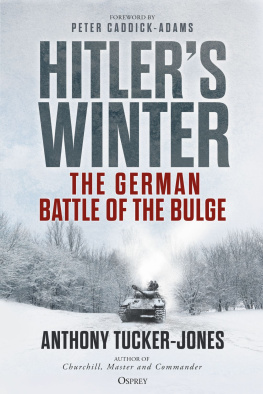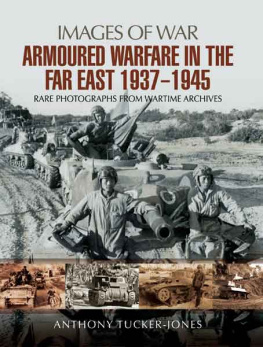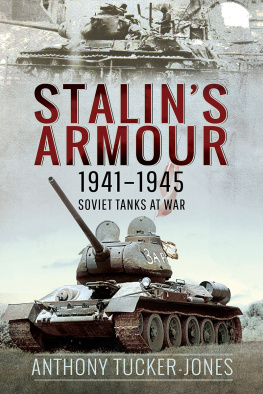This volume is for Rupert Harding, my commissioning editor at Pen & Sword Books. I have had the pleasure of working with him for well over a decade. He nurtured my second career from the start and has overseen some 50 of my titles not bad going and clearly a very fruitful partnership. Rupert, my heartfelt thanks for all your help and guidance over the years.
First published in Great Britain in 2020 by
PEN & SWORD MILITARY
An imprint of
Pen & Sword Books Ltd
Yorkshire Philadelphia
Copyright Anthony Tucker-Jones 2020
ISBN 978-1-52677-797-3
eISBN:978-1-52677-798-0
Mobi ISBN:978-1-52677-799-7
The right of Anthony Tucker-Jones to be identified as Author of this work has been asserted by him in accordance with the Copyright, Designs and Patents Act 1988.
A CIP catalogue record for this book is available from the British Library
All rights reserved. No part of this book may be reproduced or transmitted in any form or by any means, electronic or mechanical including photocopying, recording or by any information storage and retrieval system, without permission from the Publisher in writing.
Pen & Sword Books Ltd incorporates the imprints of Pen & Sword Archaeology, Atlas, Aviation, Battleground, Discovery, Family History, History, Maritime, Military, Naval, Politics, Social History, Transport, True Crime, Claymore Press, Frontline Books, Praetorian Press, Seaforth Publishing and White Owl
For a complete list of Pen & Sword titles please contact
PEN & SWORD BOOKS LTD
47 Church Street, Barnsley, South Yorkshire, S70 2AS, England
E-mail:
Website: www.pen-and-sword.co.uk
Or
PEN AND SWORD BOOKS
1950 Lawrence Rd, Havertown, PA 19083, USA
E-mail:
Website: www.penandswordbooks.com
List of Illustrations
Early production Matilda II identifiable by the Vickers machine gun mounted in the right-hand side of the turret. The smaller Besa 7.92mm was fitted in the Mk IIA. (All images sourced by author)
The British Mk VI series of light tanks were numerically the most significant armoured fighting vehicles with the British Army in 193940.
The Matilda I, or Infantry Tank Mk I, was much bettered armoured than the light Mk VI, but was very slow and armed with just a machine gun.
These Mk IVA (A13) cruiser tanks belong to the 2nd Royal Tank Regiment, 1st Armoured Division, deployed to France in 1940.
A Matilda II lost during the fighting at Arras. In 1940 it was the heaviest tank in British service, but was not available in sufficient numbers.
German troops pose on their prize a captured Matilda, numbers of which were lost during both Operations Brevity and Battleaxe in North Africa in May and June 1941.
The Crusader proved mechanically unreliable, but went into battle during Operation Crusader and continued in service until the end of the fighting in North Africa.
The Valentine joined the 8th Armys tank brigades in the summer of 1941 and played a key role in Operation Crusader.
A welcome addition to the British tank inventory was the American-supplied M3 Stuart light tank. It first arrived in Egypt in July 1941.
The American M3 medium tank, while far from perfect, was an ideal stopgap remedy to the firepower of Rommels panzers. This version is the Lee with the machine-gun cupola.
A British Sherman, which appears to be the cast hull M4A1, takes on ammunition. The British 8th Army had received about 270 Shermans by October 1942.
Grant tanks plough their way through the mud and rain in Tunisia. After the campaign ended those remaining were sent to the Far East to fight the Japanese.
M3 Lee with the 2nd Battalion, 12th Armored Regiment, US 1st Armored Division at Souk el Arba in Tunisia.
A troop of welded-hull M4A2 Shermans poised for action. Armed with a 75mm gun the Sherman first saw action at El Alamein and was a reasonable match for the panzers in Egypt and Libya.
A British Crusader II Close Support Tank, armed with a 3in howitzer, leads two Crusader IIIs (armed with the 6-pounder gun) through the town of El Hamma.
American Sherman M4A2s gathered at La Pcherie, a French naval base in Tunisia, in July 1943 ready for the invasion of Sicily.
A veteran of the North African battles comes ashore in Sicily.
Following the German surrender in Tunisia in May 1943, British Shermans were next deployed in the invasion of Sicily this one is north of Rammacca.
LST-77 offloading M4A2 Sherman tanks at Anzio, Italy, May 1944.
The remains of a New Zealand welded-hull Sherman. During the battles for Cassino in Italy tanks proved to be of limited value.
British Honey light tank on its way to the Sangro River from Baglieta, 9 December 1943.
Churchill tanks in Italy. After fighting against the Gustav Line, the British 8th Army captured Rimini and established a bridgehead over the Marno in mid-September 1944.
Upgunned Churchill IV (NA 75) shelling the Gothic Line in Italy. These were converted in Tunisia, North Africa (hence NA) when 120 Churchill IVs were fitted with M3 75mm guns and mantlets salvaged from damaged Shermans.
M4A4 Shermans in the town of Portomaggiore, north of Argenta, which was captured by the 8th Army on 19 April 1945.
M24 Chaffee, US 1st Armored Division, on the streets of Milan in late April 1945. Although work to develop a new light tank started in early 1943, the Chaffee was not standardized until mid-1944.
M3 Lee medium tanks supporting the Gurkhas during the Battle of Imphal in 1944.
Chinese M3A3 or M5A1 light tanks involved in the fighting at Bhamo, Burma in 1944.
Chinese-crewed Shermans on the Burma Road in 1945.
Stuart light tanks supporting Australian troops at Buna, during the New Guinea campaign fought from January 1942 to August 1945.
Disabled Sherman on the shoreline of Betio, Tarawa Atoll, Gilbert Islands, which the US Marines assaulted on 20 November 1943.
Flooded Sherman in the Tarawa Lagoon.
Lucky Legs II supporting US troops on Bougainville in March 1944. The island was assaulted on 1 November 1943, but the Japanese garrison held out until the end of the war.
Cover Girl of the US 775th Tank Battalion engaging Japanese troops on Luzon in the Philippines in early 1945.
The most common Allied tanks in Normandy were the Sherman M4 and M4A1 they equipped the bulk of the American, British, Canadian, French and Polish armoured forces.
At the time of D-Day upgunned Shermans were in short supply. Only 800 M4s armed with a 105mm howitzer were produced during 1943. The follow-on M4A3 105mm only went into production in April 1944.
The M4A1 and M4A3 equipped with a 76mm gun only became available in early 1944.

















